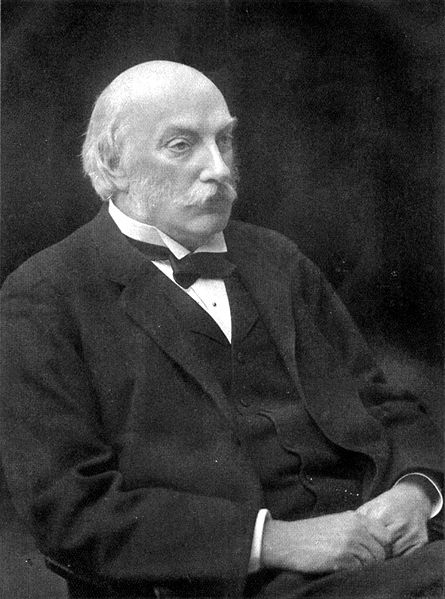<Back to Index>
- Physicist John William Strutt, 3rd Baron Rayleigh, 1842
- Composer Alexander Porfiryevich Borodin, 1833
- Provisional President of the Republic of China Sun Yat-sen, 1866
PAGE SPONSOR

John William Strutt, 3rd Baron Rayleigh, OM (12 November 1842 – 30 June 1919) was an English physicist who, with William Ramsay, discovered the element argon, an achievement for which he earned the Nobel Prize for Physics in 1904. He also discovered the phenomenon now called Rayleigh scattering, explaining why the sky is blue, and predicted the existence of the surface waves now known as Rayleigh waves. In 1910 Lord Rayleigh discovered that an electrical discharge in nitrogen gas produced "active nitrogen", an allotrope considered to be monatomic. The "whirling cloud of brilliant yellow light" produced by his apparatus reacted with quicksilver to produce explosive mercury nitride.
Strutt was born in Langford Grove, Essex, and in his early years suffered from frailty and poor health. He attended Harrow School and began studying mathematics at Trinity College, University of Cambridge, in 1861. In 1865, he obtained his BA (Senior Wrangler and 1st Smith's prize) and, in 1868, his MA. He was subsequently elected to a Fellowship of Trinity. He held the post until his marriage to Evelyn Balfour, daughter of James Maitland Balfour, in 1871. He had three sons with her. In 1873, on the death of his father, John Strutt, 2nd Baron Rayleigh, he inherited the Barony of Rayleigh.
He was the second Cavendish Professor of Physics at the University of Cambridge (following James Clerk Maxwell), and held this position from 1879 to 1884. He first described dynamic soaring by seabirds in 1883, in the British journal Nature. From 1887 to 1905 he was Professor of Natural Philosophy at Cambridge.
Around the year 1900 Lord Rayleigh developed the Duplex (combination of two) Theory of human sound localization using two binaural cues, interaural time delay (ITD) and interaural level difference (ILD) (assuming a spherical head with no external pinnae). Humans perceive sound sources spatially, using the difference in the phase (time delay) of the sound and the difference in amplitude (level) between the two ears, in a similar way that stereoscopic sight provides depth perception. The theory posits that we use two primary cues for azimuth (horizontal location) as well as for a 3-dimensional bearing, although pinnae reflections are considered a main cue for vertical localisation. For example, when you hear a seagull call, you can determine roughly the location of the sound on mental x, y, and z axes.
Lord
Rayleigh was elected Fellow of the Royal Society on
12 June 1873, and served as president of the Royal Society from 1905 to
1908. From time to time Lord Rayleigh participated in the House of Lords;
however, he spoke up only if politics attempted to become involved in
science. He died on 30 June 1919, in Witham, Essex. Craters on Mars and the Moon are named in his honor as
well as a type of surface wave known as a Rayleigh wave.
The asteroid 22740 Rayleigh was named in his honour on
1 June 2007. He was awarded the Smith's Prize (1864), the Royal Medal (1882), the Matteucci
Medal (1894),
Member of the Royal Swedish
Academy of Sciences (1897),
the Copley
Medal (1899), Order of Merit (1902), the Nobel
Prize for Physics (1904)
and the
Rumford Medal (1914
& 1920).